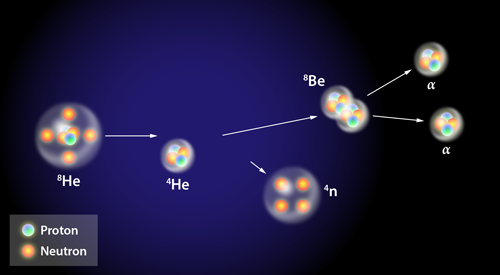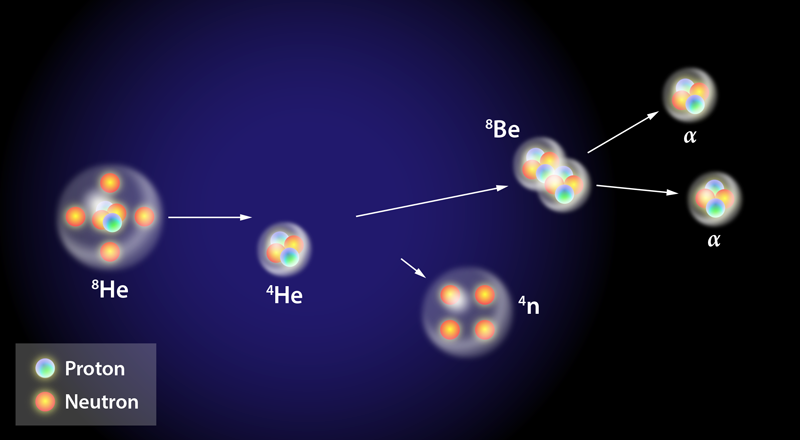Can Four Neutrons Tango?
The fundamental ingredient for constructing a nucleus from scratch is the force between two nucleons. The most attractive interaction occurs between the proton and neutron, as evidenced by the ground state of the deuteron, which is bound by 2.2 MeV. In contrast, bound states of two protons ( 2He) or the “dineutron” ( 2n) do not exist, although the latter falls short by only some 100 keV. Intriguingly, however, theoretical models have revealed in recent years the importance of three-body and other multinucleon forces in binding light nuclei. As such, the question of whether a four-neutron system, or “tetraneutron,” exists may be posed. Tantalizing evidence for the tetraneutron, in the form of a resonant, or unbound, state, has been uncovered in an experiment performed at the RIKEN Radioactive Ion Beam Factory (RIBF), in Saitama, Japan [1]. Confirming this finding has the potential to change our understanding of nuclear interactions and provide a new window into the physics of few-body systems. Further afield, it would also have ramifications for our understanding of neutron stars [2].
Nuclear physicists first began searching for the tetraneutron ( 4n) more than half a century ago [3]. In the ensuing years, they employed a wide variety of techniques to detect it (indirectly), including fission, so-called pion-induced double-charge exchange on helium-4 ( 4He), and complex reactions involving the transfer of multiple nucleons. In more recent times, the development of energetic beams of radioactive nuclei (see, for example, 30 April, 2012 Viewpoint) has opened up new avenues for 4n searches. In 2002, following a long hiatus in these efforts, a French-led collaboration [4] reported the observation of a handful of events in the breakup of beryllium-14—the most neutron-rich beryllium isotope—that were consistent with the detection of a bound [4] or resonant 4n system [5]. Although subsequent attempts to observe the tetraneutron were unsuccessful [6], theorists began to explore the question of its existence using new tools. These included methods built on recently developed ab intio approaches, in which the nucleus is constructed from the constituent nucleons. These efforts found no realistic means to generate a bound system of four neutrons [7]. Less attention was paid to the possibility of a resonant four-neutron system—that is, an unbound system existing for long enough (typically of order 10−21s) that a well-characterized state (spin, parity, and energy) can be defined. The most sophisticated calculations, however, have suggested that a narrow resonance, with an energy near the threshold energy to bind four neutrons, is also very unlikely.
Yet the new work suggests the tetraneutron may in fact exist as a resonance, which is only unbound by around 1 MeV. Perhaps fittingly, the researchers identified four such events. The experiment, performed by a collaboration led by Keiichi Kisamori and Susumu Shimoura from the Center for Nuclear Study of the University of Tokyo, Japan, was a tour de force, involving old and new techniques. The old was employing a double-charge-exchange reaction on a 4He target; the new was the use of a beam of very high-energy radioactive helium-8 ( 8He)—the most neutron-rich helium isotope. Specifically, the experiment focused on the 4He(8He,8Be)4n reaction (Fig. 1). This involved directing the 8He beam onto a liquid 4He target and analyzing the reaction products using RIKEN’s high-resolution SHARAQ spectrometer to identify the 8Be.
In the experiment, the researchers did not detect the four-neutron system directly, as this is essentially impossible for the very low-energy neutrons that result from the 4He(8He,8Be)4n reaction. Rather, they used the “missing mass” method in which they deduced the momentum (and hence energy) of the four-neutron system from their measurement of the momenta of the 8He and of the two alpha particles ( 4He nuclei) produced by the decay of 8Be. The 4He(8He,8Be)4n reaction is of note in two respects. First, and most importantly for this study, it results in the transfer of almost no recoil momentum to the four-neutron system, thus avoiding disrupting the 4n. Second, the two alpha particles from the 8Be have a small, well-defined relative energy and angle. While complicating the experiment, the detection of two such alpha particles provides an excellent signal to isolate the 8Be against the experimental backgrounds.
Several factors make the RIKEN experiment difficult. In particular, the beam, while being the most intense one of energetic 8He available (2 million particles per second), is still ten thousand times less intense than beams of stable nuclei. Moreover, the cross section, or probability, for the 4He(8He,8Be)4n reaction is extremely low (4 nanobarns), some 5 orders of magnitude below that of typical experiments with radioactive beams. Consequently, despite accumulating data for around a week—a relatively long run for the heavily overbooked RIBF—the authors only observed four events in the energy range of interest. At first glance this observation may seem to be of limited significance: the statistical uncertainty for four events is two events. However, the collaboration provided more weight to the result by performing a sophisticated statistical analysis, similar to that employed in the discovery of the Higgs boson. In simple terms, they calculated the chance of finding four counts within a few MeV of the threshold energy, given the estimated shape of the full spectrum (the experimental background plus the spectrum of events for four neutrons when no resonance occurs). This analysis indicated a statistical significance for the four events of close to 5𝜎, the typical criterion for claiming a discovery. However, because the researchers made certain assumptions, including the form of the continuum, they were careful to refer to the four events as corresponding to a “candidate” resonant state.
This result is certain to revive interest in the tetraneutron. On the theoretical side, efforts are already underway to understand if and how its existence can be explained. The role of multinucleon forces is the obvious lead to follow. Preliminary calculations, however, suggest that an unphysically strong three-neutron force is required to generate a 4n resonance within a few MeV of threshold [8]. On the experimental side, it is an understatement to suggest that further data are required. Motivated by the present results, the RIBF has just approved a proposal, by Shimoura and colleagues, for an improved experiment. Its goal will be to ameliorate the statistics of the measurement by an order of magnitude and reduce the uncertainty in the energy of the 4n resonance (currently around 1.3MeV) by a similar factor. Importantly, experimentalists will also attempt to observe the 4n using different techniques. These will include producing the 4n from the “breakup” of energetic beams of very neutron-rich light nuclei and then directly detecting the four neutrons from their decay. Many nuclear physicists may still be skeptical that the 4n exists, even as a resonance. However, the implications, including our understanding of some of the fundamental features of nuclear interactions, are such that these experiments at the limits of our capabilities must be pursued.
This research is published in Physical Review Letters.
References
- K. Kisamori et al., “Candidate resonant tetraneutron state populated by the 4He(8He,8Be) reaction,” Phys. Rev. Lett. 116, 052501 (2016).
- K. Hebeler et al., “Constraints on Neutron Star Radii Based on Chiral Effective Field Theory Interactions,” Phys. Rev. Lett. 105, 161102 (2010).
- J.P. Schiffer and R. Vandenbosch, “Search for a Particle-Stable Tetra Neutron,” Phys. Lett. 5, 292 (1963).
- F. M. Marqués et al., “Detection of Neutron Clusters,” Phys. Rev. C 65, 044006 (2002).
- F. M. Marqués et al., “On the Possible Detection of 4n Events in the Breakup of 14Be,” arXiv:nucl-ex/0504009.
- See, for example, S. Fortier et al., “Search for Resonances in 4n, 7H and 9He via Transfer Reactions,” AIP Conf. Proc. 912, 3 (2007).
- Steven C. Pieper, “Can Modern Nuclear Hamiltonians Tolerate a Bound Tetraneutron?,” Phys. Rev. Lett. 90 (2003), and references therein.
- E Hiyama et al., “Can T=3/2 Isospin 3-neutron Forces Generate a Narrow 4-Neutron Resonance?” (unpublished).





